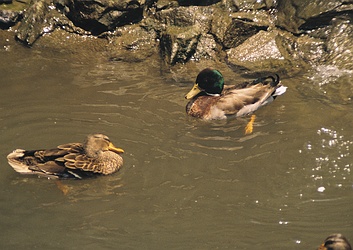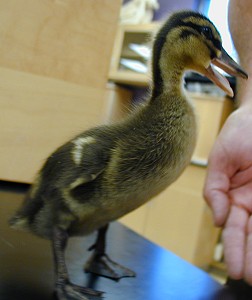|
Project Quack
|
|
Mallard |
 |
The Mallard Duck breed is said to be
the breed from which all domestic duck breeds originated, except for the
muscovy duck. Other names this duck is known as are the Common Mallard, Common
Wild duck, Curly-tail, Domestic duck, English duck; French duck, gray duck,
gray mallard, greenhead and stock duck. The average lifespan of a Mallard is 11
years. |
| The drake has an
iridescent green head, a white collar around his neck, a brownish-red breast
and a silver stomach. His tail feathers are often curly. However, ducklings do
not get their distinctive feathers until they are about 16 weeks of age. The
hen is a mellow but attractive combination of almond and golden browns with
black penciling. Both the drake and hen have reddish-orange legs, a brown beak,
and royal blue speculums that are outlined in white. |
|
|
|
| Mallards are a small breed of duck, also known as a
bantam breed, measuring about 20-23 inches long and weighing around 2-3 lbs.
Mallard Ducks are successful brooders that lay blue-greenish eggs. They are
self reliant, outstanding mothers and will hatch a high percent of their eggs.
Mallards feed by "dabbling" and tipping their bodies into water, bill first,
tail in the air, to search for food. The Mallard Duck uses its bill to filter
food from the mud. These ducks are also very vocal. Male Mallards make soft,
muffled sounds, and the female quacks loudly. Mallards can eat anything from
grass, water plants, nuts, acorns, to crayfish. Mallard ducklings begin to fly
by the time they are two months old. |
 |
|
| |
|
|
| |
|
|
| |
 Webspinner Table of Contents Webspinner Table of Contents |
|